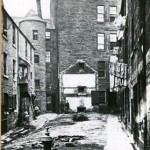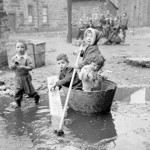The industrialization of towns and cities across Scotland in the early 1800s, resulted in huge increases in population as people moved from rural areas to towns for work. The population in Dundee rose from 26,000 in 1801 to a staggering 166,000 in 1840 with the development of textile, shipbuilding and whaling industries. Housing and sanitation couldn’t keep pace with such expansion and many working class families, including the Slessors, ended up living in overcrowded slum areas with little or no sanitation.
With no welfare state at this time, families without a regular income could fall quickly into desperate circumstances, suffering from hunger and disease, with infant mortality extremely high.
Many people tried however to retain an image of respectability despite their desperate living conditions, especially in front of those of authority, such as church elders, even if this meant going to the pawn shop on a Saturday night to retrieve Sunday best clothes to attend church the next morning.



